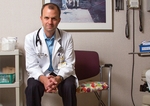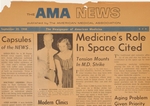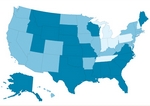profession
Medical student training in EHRs found lacking
■ Although more than 60% of med schools offer some education in electronic health records, the level of access varies.
- WITH THIS STORY:
- » External links
As more hospitals, clinics and physician practices make the transition to electronic health records, many medical schools are grappling with how to train the next generation of physicians to use the systems.
Schools face multiple challenges in trying to integrate EHRs into their curricula, such as billing issues and limitations within the systems that make them inconducive for educational purposes. But medical schools should be cautious in placing limitations on students that might prevent them from becoming competent in EHR use, said Lynn Cleary, MD, a professor at Upstate Medical University at State University of New York in Syracuse.
“Schools have a responsibility to graduate students with the expertise and sense of duty in the basics of practice,” she said. “The EHR is now part of that skill set.”
Fifty-five percent of physician offices nationwide used EHRs in 2011, up from nearly 51% in 2010, according to Centers for Disease Control and Prevention statistics released July 17.
Meanwhile, 64% of medical schools allow students to use EHRs, and two-thirds of those allow students to make notes in the records, according to a study in the July 24 Teaching and Learning in Medicine. Those statistics come from a survey of 338 clinical directors nationwide conducted by the Alliance for Clinical Education, a multidisciplinary group of medical educators aimed at enhancing clinical training for future physicians.
Students’ ability to access EHRs varies, the study said. Twenty-seven percent of survey respondents said students were allowed to view and write patient notes and enter patient orders to be co-signed. Forty-one percent said students could view and write notes but not make orders.
Although the majority of students are allowed to enter notes, many schools marginalize students’ contributions by not considering their notes part of the official medical record, said Dr. Cleary, president of the alliance.
Implementing EHR training
To help schools, the alliance developed guidelines on implementing EHR instruction that were published in conjunction with the study. The group’s recommendations include giving students the chance to do order entry for real or simulated patients, exposing students to the decision aids that are built into many EHR systems, and giving students the chance to make notes in a patient’s chart.
“We hope that medical schools and faculty recognize that students need to be more integrated in the team and not excluded from utilizing the EHR,” said Maya M. Hammoud, MD, lead author of both articles and associate professor of obstetrics and gynecology at the University of Michigan Medical School. “This can jeopardize their learning and their effectiveness as future physicians.”
Some of the barriers to EHR instruction cited in the survey were that many systems do not have a mechanism that allows residents or faculty to review student order entries. Respondents also cited concerns about billing challenges, a lack of computers available for instructional purposes, student errors that might go undetected because of the structure of some EHRs and the steep learning curve for faculty unaccustomed to EHRs.
Some respondents said they felt students spent too much time watching preceptors type entries into an EHR when they could be seeing patients. Such concerns are frequently cited with EHRs in general and seem to be more prevalent among older physicians who are less experienced with computers, said Dr. Hammoud, chair of the alliance’s research committee.
“Definitely, more practice and familiarity will help,” she said. “Our data show higher physician satisfaction with longer use of the EHR.”
Allowing students the ability to write patient notes long has been an integral part of medical education, and taking that away puts students at a disadvantage, Dr. Hammoud said.
“We think that faculty who are trusted with patient care can also be trusted to supervise students and their written work,” she said. “Institutions need to recognize the importance of training medical students and integrating their notes in the EHR.”












